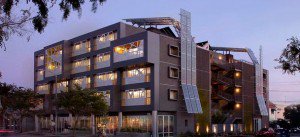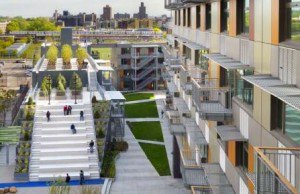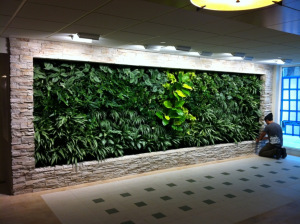By Erica Rascón on August 20, 2013 in News
Green building has gained momentum in the affordable housing sector, providing some of society’s marginalized residents with hip, eco-friendly—and budget friendly—living accommodations.

It has been a long time coming but it is finally here: affordable housing has blossomed from the ugly ducklings of architecture into beautiful swans, complete with coveted interiors, state-of-the-art green features and unique exteriors that boost local pride.
As experience plucks away the myths that surround green building expenditures, more cities seek developers who are willing to offer sustainable, beautiful solutions for low-income housing. This shift is a reasonable route to take; studies suggest that low-income residents are in the greatest need of cash savvy and health conscious resources.
The Uphill Crawl
Just as quickly as builders gained consciousness of sustainable development in the 60s and 70s, they seemed to forget. By the 1980s, green building lost its momentum. The housing industry witnessed a notable increase in green building projects at the turn of the 21st century. Though the economy struggled towards the end of the first decade, the number of green building projects in the pipeline continued to increase. Such proposals and have now reached record heights.
While the amount of green building certifications increased for traditional housing, businesses and institutions, green affordable housing lagged woefully behind. Various organizations released reports on the benefits of green building within affordable housing—such as The Cost and Benefits of Green Affordable Housing and Green Affordable Housing Within Our Reach—but cities and builders proved slow to catch on. Within the last seven years, however, this sector has welcomed an influx of environmentally conscious projects.
Planetizen released a summary of Global Green USA’s Progress and Possibilities Report, indicating that affordable green building has become a priority for many states’ Qualified Allocation Plans. States now implement more

third-party standards to measure the sustainability of new builds and renovations. In the first report, issued in 2005, only 8 states listed third-party green building certifications. The most recent report listed 15 states with the majority of funded, low-income housing projects in pursuit of green building certification.
Many municipalities have come to realize that sustainable building offers an array of direct and indirect returns. In addition to potential savings on building and operation costs, cities that support green, low-income housing may experience the following benefits:
- Increased health initiatives may decrease long-term healthcare costs. Today’s green building projects focus on environmental and health benefits. By targeting respiratory illnesses, mental health, and physical activity levels, green building takes a holistic approach to lowering the health concerns that plague communities. Researchers are discovering that such considerations lead to quantifiable results.
- Sustainable development and environmental awareness can decrease long term infrastructure costs. By implementing rainwater harvesting, native landscaping, green stormwater management and similar techniques, cities can reduce development and maintenance cost for infrastructure. Environmental awareness programs can also contribute to a decline in household waste and litter, which alleviate public sanitation expenses.
- Green building minimizes reliance on limited resources. Over time, cities may find it easier to accommodate their growing populations without costly overhauls of their existing power, fuel and water filtration systems. As an added benefit, low-income families can conserve much-needed financial resources. According to The Cold Facts, low-income households spend nearly 20 percent of their annual income on energy costs; in contrast, median income households spend less than 5 percent. As individual households conserve resources, the savings will be reflected to providers.
- Green building provides investors with solid returns and less risk. Eco-friendly builds continue to hold investors’ interest. Green housing consistently have lower tenant-turnover rates as well as lower utility bills.
Trailblazers: Successful green projects
With dozens of successful green affordable housing complexes on the records, cities now have access to case studies that can plead the case for further sustainable development. These pioneer projects forge a path for wiser development choices for cities across the globe.
Sierra Bonita Apartments of Los Angeles is a low-income housing development in West Hollywood. 42 units created specifically for residents with special needs rest atop of shops and businesses in a trendy mixed-use facility. Solar electric panels provide power for the five story structure. Sierra Bonita Apartments is the brainchild of Tighe Architecture in collaboration with the community group, WeHo’s Green Building Ordinance, which aims to create a legacy of eco-friendly projects in the area.
Phipps CDC property selected the Bronx as the site of Via Verde, the LEED Gold Certified co-op that has city views unmatched by much pricier locales. Designers opted for a terrace-style design that offers views—as well as natural light, natural ventilation—to residents with center units as well as corner units. 40,000 square feet of vegetated roofs top-off the building, providing complementary climate control to the south-oriented photovoltaic arrays. A rainwater harvesting system, high-efficiency condensing boilers, and multiple public spaces that promote physical activity top the list of distinguishing features. The site offers over 220 apartments for low- and median-income families.

Also in the Bronx, LEED platinum certified Arbor House is home to 124 units of green affordable housing.
The most breathtaking sustainable features include lush living walls, stairways drenched in natural light, and a 10,000 square foot hydroponic rooftop farm. What remains unseen is equally important: designers focused on improving the interior air quality as well as cleaning the air immediately surrounding the building. The urban site, like many others, has a significant population of residents with respiratory ailments. Efficient air filtration systems, ample green spaces, low and no-VOC finishes contribute to improved air quality.
Los Vecinos, a project of Wakeland Housing & Development Corporation, is the first LEED Platinum low-income housing community in San Diego. At 100% solar power, the development thrives with little- to no- drain on the power grid. Natural ventilation, tankless water heaters, and low-flow water contribute to a greener lifestyle for all residents. Los Vecinos is a fine example of a green infill project. The site was previously home to a decrepit motel.
Intervale Green boasts 128 apartments for low-income and formerly homeless New Yorkers. On the outside, Intervale tenants enjoy nearly an acre of green space, including a rooftop farm. Stellar insulation is provided by an intricately designed building envelope that also supports healthy ventilation. Nontoxic and zero-VOC finishes also minimize health risks. Behind the scenes, 85 percent efficient boilers and hot water heaters keep residents comfortable while energy efficient appliances, fixtures, and low-flow faucets encourage low utility bills.
Additional scholarship on the opportunities presented by green building is still in demand yet what is available seems promising. Built environments that are in sync with the natural environment and minimize adverse effects on residents’ health stand to offer more to their communities, especially when they also bring solid returns.
Are there any green, affordable housing communities in your area that are gaining recognitions for their contributions to the community?


